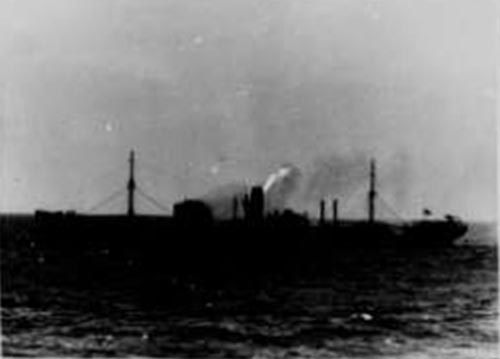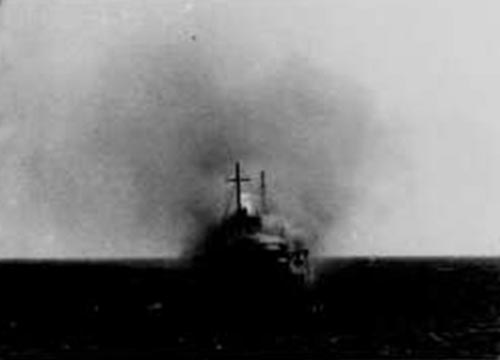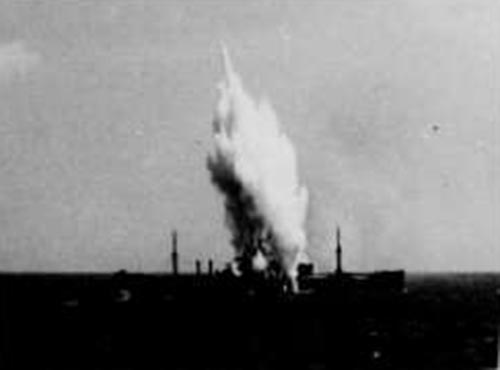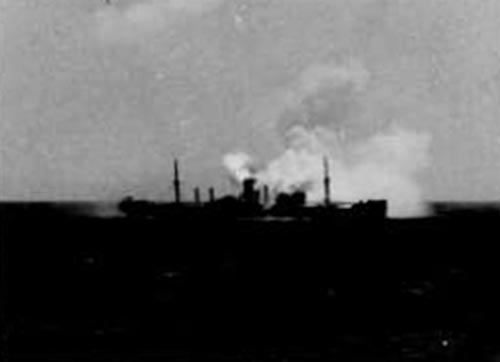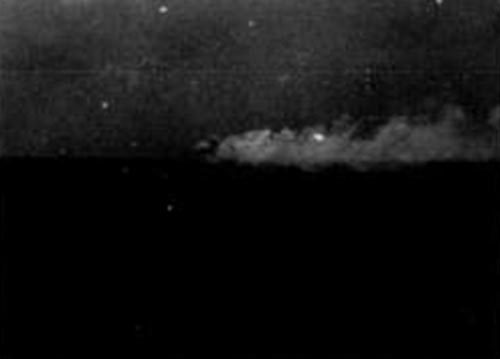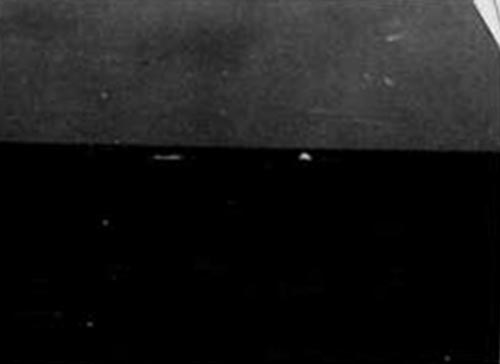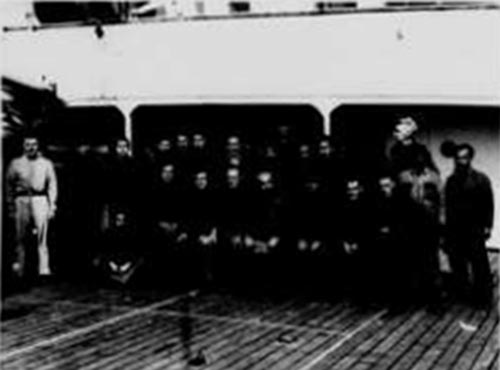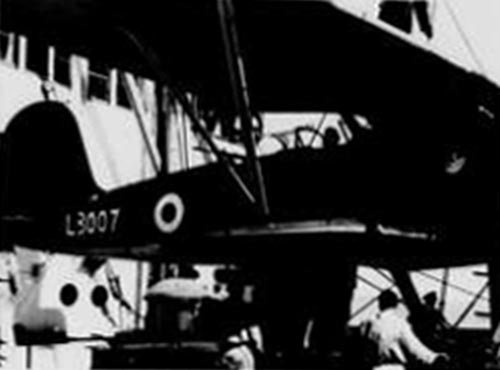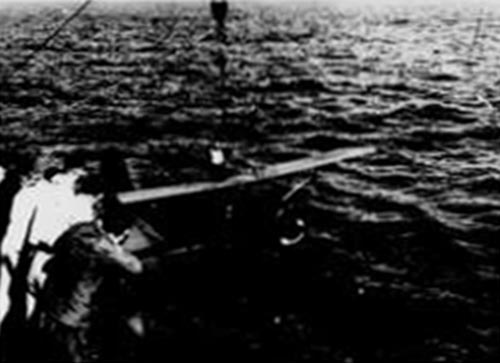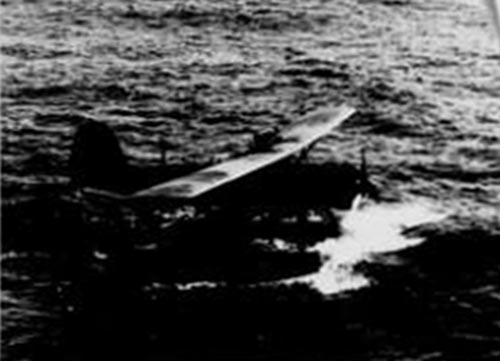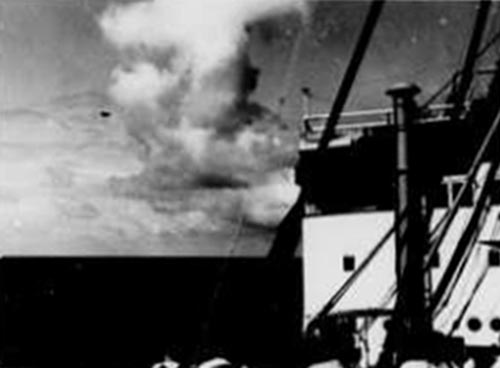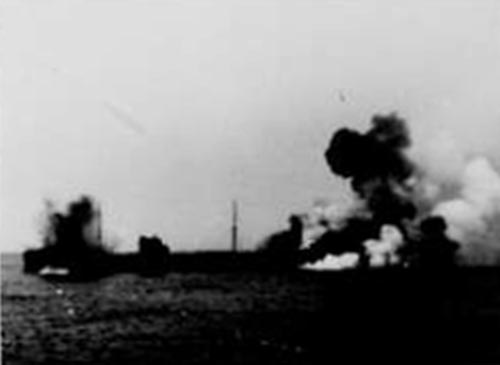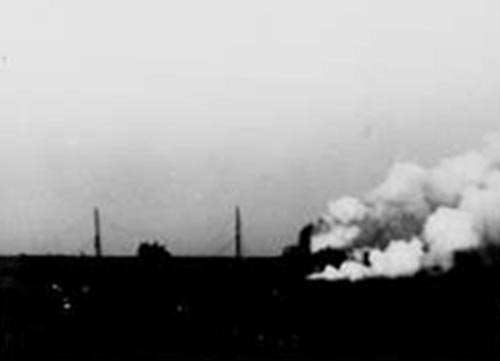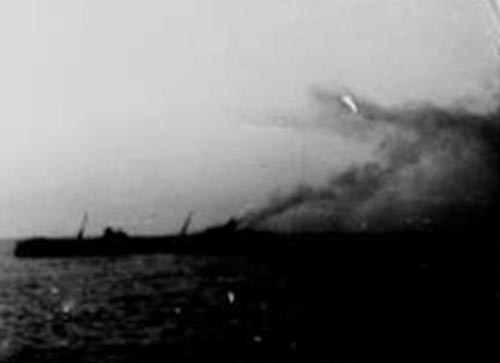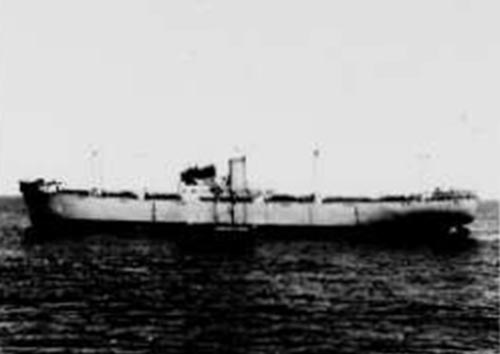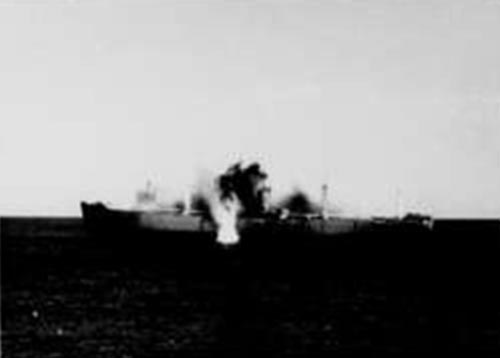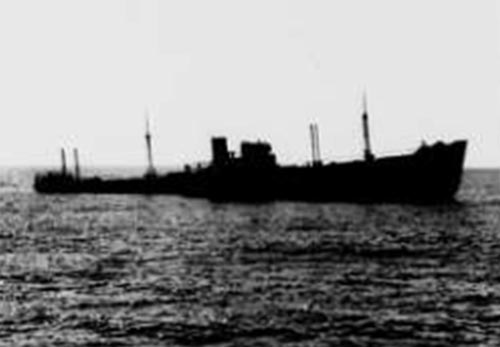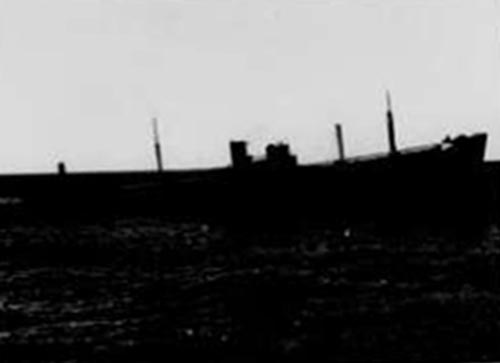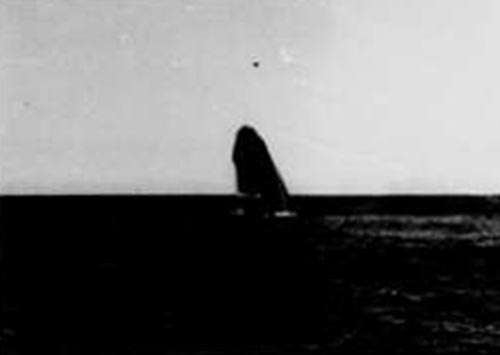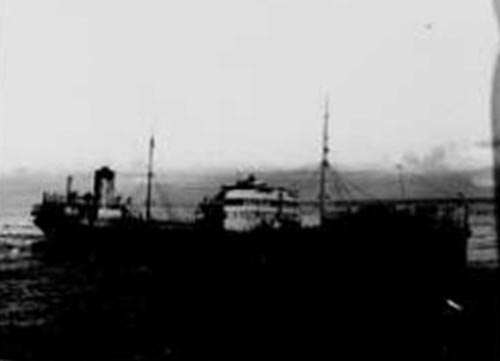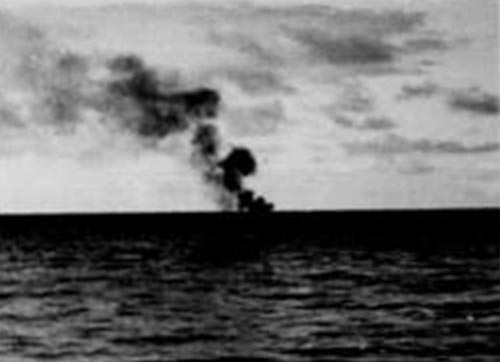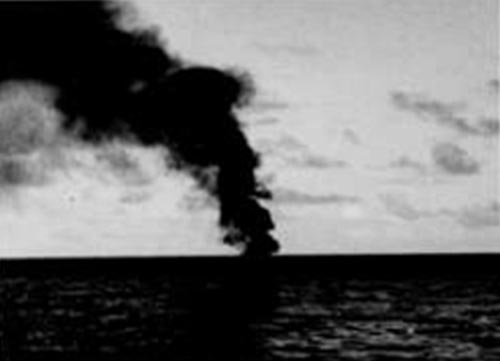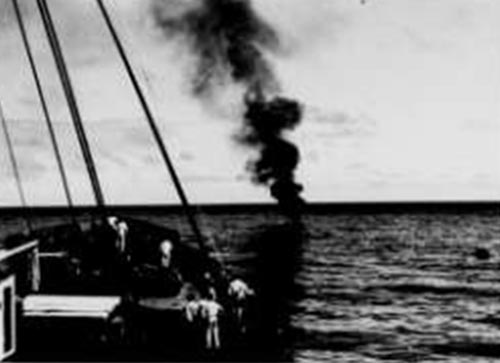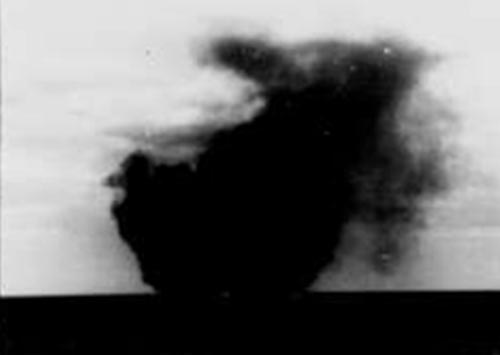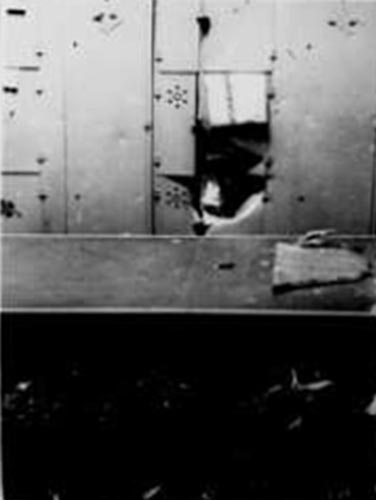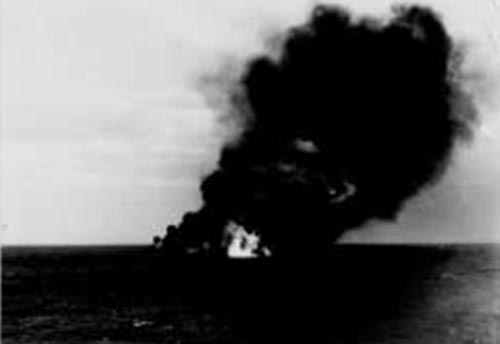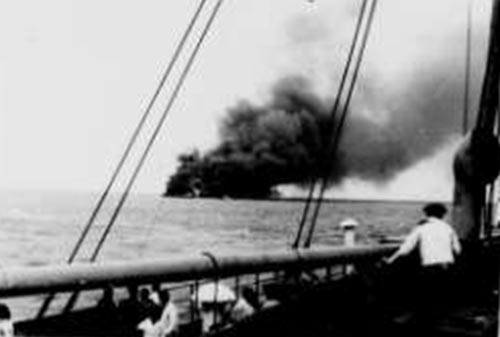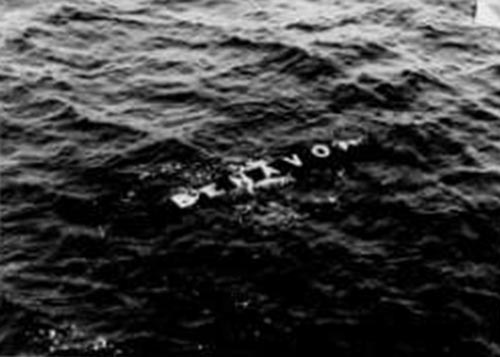| |
- 35 - |
|
| |
|
|
|
|
|
| |
|
|
|
|
|
| |
|
|
|
|
|
| |
|
|
|
|
|
| |
|
|
|
|
|
| |
|
|
Following the ship's assignment per Radio Message: |
|
| |
|
|
|
|
|
| |
|
|
To all Atlantic Forces (No. 81, 82, 83) of 24 July 40 |
|
| |
|
|
|
|
|
| |
|
|
of a newly allocated operating area in the Cape Town sea area, I initially intend to head for the northwest corner of this area at o 0° longitude and 20°S latitude. |
|
| |
|
|
With the Kommandanten UA, whose next destination in Freetown, a joint transit course of 120° is agreed up to about the presumed steamer route and, possibly convoys from South America to Freetown. With that, UA will then head for Freetown. In the event of an encounter with the "cruiser" DORSETSHIRE "which, according to the news transmitted, is currently to patrol this sea area, joint operations are planned. As long as seamanship allows, UA is to be towed. |
|
| |
|
|
|
|
|
| |
|
|
|
|
|
| |
|
|
|
|
|
| |
|
23.00 |
The lights of a steamer come in sight ahead to port approximately head on. Course of the steamer about 320°. UA broke off to take a closer look at the steamer. Ship 33 remained in the dark and showed a narrow silhouette when the moon rose. |
|
| |
|
|
On return, the Kommandant informs me that he had shot a torpedo at the steamer (tanker), which, however, as a circle runner, he only narrowly escaped. |
|
| |
|
|
He wants to have the torpedoes checked again before further damage. The torpedo detonated at the end of its running time. However, the steamer did not take notice of any maneuvers of the U-Boat or of the torpedo detonation that took place at a greater distance from him, drove on calmly and continued to maintain radio silence, so it can be assumed we were unnoticed. |
|
| |
|
|
|
|
|
| |
|
|
|
|
|
| |
|
|
|
|
|
| |
|
|
|
|
|
| |
|
|
|
|
|
| |
|
|
|
|
|
| |
|
|
|
|
|
| |
|
|
|
|
|
| |
|
|
|
|
|
 |
 |
 |
 |
 |
 |
| |
- 36 - |
|
| |
|
|
|
|
|
| |
|
|
|
|
|
| |
|
|
|
|
|
| |
|
continued |
|
|
|
| |
|
26.07.40 |
|
UA was taken in tow again. |
|
| |
|
03.40 |
|
The towline breaks in strong oncoming Swell. |
|
| |
|
|
|
We now proceed separately. |
|
| |
|
|
|
|
|
| |
|
|
|
|
|
| |
|
12.00 |
07°43'N 34°00'W |
|
|
| |
|
|
SW 2, Sea 1, clear, Vis. good |
|
|
| |
|
|
|
|
|
| |
|
|
|
|
|
| |
|
|
|
|
|
| |
|
27.07.40 |
05°47'N 30°03'W |
No particular events. |
|
| |
|
12.00 |
SEbyS 3, Sea 2-3, clear, Vis. good |
|
|
| |
|
|
|
|
|
| |
|
|
|
|
|
| |
|
|
|
|
|
| |
|
28.07.40 |
03°46'N 26°28'W |
Said goodbye to UA, sets off on course 90° to reach the suspected steamer route to Freetown by the shortest route. |
|
| |
|
12.00 |
SSE 3-4, Sea 3, clear, Vis. good |
|
| |
|
|
|
|
|
| |
|
|
|
Came to course 136°. |
|
| |
|
|
|
|
|
| |
|
|
|
|
|
| |
|
|
|
 |
|
| |
|
|
|
|
|
| |
|
|
|
|
|
| |
|
|
|
|
|
| |
|
|
|
|
|
| |
|
|
|
|
|
| |
|
|
|
|
|
| |
|
|
|
|
|
| |
|
|
|
|
|
 |
 |
 |
 |
 |
 |
| |
- 39 - |
|
| |
|
|
|
|
|
| |
|
|
|
|
|
| |
|
|
|
|
|
| |
|
continued |
|
|
|
| |
|
31.07.40 |
|
|
|
| |
|
10.55 |
|
At 4000 meters range tuned away by 35°, set war flag, steamer was asked to stop by flag signal and fire was opened because it is an armed English steamer on the run, which transmits emergency signals and location by Radio Message and whose guns are being manned. |
|
| |
|
11.00 |
|
The crew left the ship in 3 boats. Also rafts were launched. The steamer burns in the superstructure. |
|
| |
|
|
|
|
|
| |
|
11.20 |
|
Examination team goes aboard. |
|
| |
|
|
|
It was the English steamer "DOMINGO DE LARRINAGN" home port Liverpool, 5358 tons, cargo 7500 tons of grain from Bahia Blanca for Newcastle via Freetown. |
|
| |
|
|
|
The crew is from the north. 4 dead are found on deck, the steamer burns. |
|
| |
|
|
|
1 demolition crate was brought out and set in place, however the igniter failed. |
|
| |
|
|
|
In the meantime the occupants of the 3 boats, in total 32 men, of these 4 severely, 4 lightly wounded, were taken on board one after another. |
|
| |
|
|
|
The crew consisted of: |
|
| |
|
|
|
| Captain |
William |
Chalmers |
| 1st Officer |
Arthur |
Ramshow, lightly wounded |
| 2nd Officer |
Cyrl |
Plummer, severely wounded |
| 3rd Officer |
Harald |
Roberts, severely wounded |
| Radio Officer |
Harald |
Morrison, severely wounded |
| 1st Engineer |
James |
Barnes |
| 2md Engineer |
Joh. |
Prier |
| 3rd Engineer |
Gustaf |
Shon |
| 4th Engineer |
James |
Harris |
| |
|
|
| 9 English |
|
1 Swede |
| 2 Spanish |
|
4 Japanese |
|
| |
|
|
|
|
|
| |
|
|
|
|
|
| |
|
|
|
|
|
 |
 |
 |
 |
 |
 |
| |
- 45 - |
|
| |
|
|
|
|
|
| |
|
|
|
|
|
| |
|
|
|
|
|
| |
|
continued |
|
|
|
| |
|
31.07.40 |
|
Shortly after the onset of darkness for a short time on the horizon the masts and smokestack of a southerly steering steamer in sight. In the meantime it has grown dark, therefore for the above reason it was not operated on further. |
|
| |
|
|
|
|
|
| |
|
|
|
|
|
| |
|
|
|
|
|
| |
|
|
Captain William C h a l m e r s of the sunken steamer "DOMINGO DE LARRINAGA" said the following when interrogated by the First Prize Officer: |
|
| |
|
|
His ship was 5,358 GRT size, 3243 NRT [= Net Registered Tonnage] and was on the way from Bahia Blanca to Freetown and from there understood further in convoy probably for Newcastle. It had about 7500 tons of grain for order. His shipping firm was the Larrinaga Steam Ship Company, Liverpool. He himself is a Scottish, 58 years old and resides in Carnovstie (Scotland). |
|
| |
|
|
The course he steered was prescribed to him by the British Consul in Bahia Blanca. From Bahia for the first 2 days he steered east and then approximately in the center of the Atlantic changing course about every 24 hours. Since yesterday evening, 30 July, he had steered 30°. |
|
| |
|
|
He further states that yesterday evening, 30 July, he saw a steamer whose course he was unable to pinpoint precisely because it was only faintly visible on the horizon. In any case, he turned around and steered south for about 4 hours and then on his usual course again. We also seemed suspicious to him, so he half changed course. He said he hadn't seen any flag signals until the moment we changed course to port. At that moment he told the First Officer to find out which flags we had set. But shortly thereafter received our first volley. He admits having sent an emergency call by radio stating his position and that he was being chased by a suspicious ship. He had not given the order to ready the cannon, but ordered that they stand ready by the boats. He says he intended to stop after the warning shot. |
|
| |
|
|
|
|
|
| |
|
|
|
|
|
| |
|
|
|
|
|
| |
|
|
|
|
|
| |
|
|
|
|
|
| |
|
|
|
|
|
| |
|
|
|
|
|
| |
|
|
|
|
|
| |
|
|
|
|
|
| |
|
|
|
|
|
 |
 |
 |
 |
 |
 |
| |
- 46 - |
|
| |
|
|
|
|
|
| |
|
|
|
|
|
| |
|
|
|
|
|
| |
|
continued |
|
|
|
| |
|
31.07.40 |
When, on the orders of the Kommandanten, he was reproached by the Prize Officer that he had treated the life of his crew carelessly, because he had not heeded our flag signals, but tried to escape and gave a signal that people were tampering with the cannon, replied he said he had just gone by orders. |
|
| |
|
|
He also stated that he did not know the positions of any warships here in the South Atlantic. Only from Freemantle would the convoys be assembled, usually 16 to 22 ships, and then brought to England under the protection of a cruiser, a second destroyer and about two trawlers. That convoy had existed since around January 1940. |
|
| |
|
|
During the war he himself had made two trips to South America and one trip to the United States in February/March. On the last voyage he had coal for Freemantle and proceeded from there to Argentina. |
|
| |
|
|
Under his papers he had manifests and bills of lading, ship certificates and crew lists. |
|
| |
|
|
His crew consisted of 38 men, of these 32 were on board the ship. Among the crew were Spanish, Malayan, Japanese and Africans, but all of them lived more or less a long time in England. |
|
| |
|
|
The armament consisted of a 10 cm cannon with 40 rounds of ammunition. The cannon was stamped from the year 1917. He stated that he had a trained gunner on board and that other people were trained by him. But he did not want to give the names of these people because he supposedly did not know them. |
|
| |
|
|
|
|
|
| |
|
|
|
|
|
| |
|
|
|
|
|
| |
|
|
|
|
|
| |
|
|
|
|
|
| |
|
|
|
|
|
| |
|
|
|
|
|
| |
|
|
|
|
|
| |
|
|
|
|
|
| |
|
|
|
|
|
| |
|
|
|
|
|
| |
|
|
|
|
|
| |
|
|
|
|
|
| |
|
|
|
|
|
| |
|
|
|
|
|
| |
|
|
|
|
|
 |
 |
 |
 |
 |
 |
| |
- 47 - |
|
| |
|
|
|
|
|
| |
|
|
|
|
|
| |
|
|
|
|
|
| |
|
|
|
|
|
| |
|
|
The gunner John Mullen said that he was 24 years old, and up to now had not been to sea, in Glasgow he received a month long training from the Navy in handling the 4" cannon, then sent by the merchant marine on board the "DOMINGO DE LARRINAGA" and here entrusted with the existing 4" cannon. Once a week he did gunnery drills with 7 men of the crew. The Second and Third Officers were among these 7 men. |
|
| |
|
|
The cannon was said to have been older, from 1916 and he had 42 rounds of ammunition to dispose of. |
|
| |
|
|
4 blacks and 1 Japanese belonged to the cannon crew. |
|
| |
|
|
He admits that he tampered with the cannon, allegedly only to get his binoculars there. He did not receive an order to shoot. |
|
| |
|
|
Mullen appears intelligent. He states that he did not serve in the Navy and that he previously worked as a shoemaker. |
|
| |
|
|
There was no range measuring equipment on board. |
|
| |
|
|
There was nothing more to be got out of Mullen. |
|
| |
|
|
|
|
|
| |
|
|
|
|
|
| |
|
|
|
|
|
| |
|
|
|
|
|
| |
|
|
Finally, with today's success, I it is especially gratifying pleasing that the position of a German commerce raider becomes known at a time when the English Admiralty is warning of a German raider, which last on 28 July was sighted at 24°S, 31°W on course 180° (Ship 10) and the location of Ship 21 in the North Atlantic must also be assumed to be known. |
|
| |
|
|
In this way, in my opinion, through the palpable presence of various commerce raiders, the desired insecurity is best created for the enemy and he is forced to strengthen the protection his shipping overseas. |
|
| |
|
|
|
|
|
| |
|
|
|
|
|
| |
|
|
|
|
|
| |
|
|
|
|
|
| |
|
|
|
|
|
| |
|
|
|
|
|
| |
|
|
|
|
|
| |
|
|
|
|
|
| |
|
|
|
|
|
| |
|
|
|
|
|
 |
 |
 |
 |
 |
 |
| |
- 49 - |
|
| |
|
|
|
|
|
| |
|
|
|
|
|
| |
|
|
|
|
|
| |
|
|
|
|
|
| |
|
02.08.40 |
14°56'S 16°24'W |
No particular events. |
|
| |
|
|
EbyS 5-7, Sea 4-5, overcast, showers, Vis. good to bad |
|
|
| |
|
|
|
|
|
| |
|
|
|
|
|
| |
|
03.08.40 |
18°29'S 15°09'W |
|
|
| |
|
03.00 |
EbyN 5, Sea 4, cloudy, squalls, Vis. good |
A Radio Message makes known the positions of two American steamers passing each other on the Cape Town - Trinidad route. There is a danger of meeting both steamers at their meeting point. For this reason, we ran for 3 hours at an increased speed to the NE, then came back to base course, 160°. |
|
| |
|
|
|
|
|
| |
|
04.08.40 |
20°34'S 13°47'W |
No particular events. |
|
| |
|
12.00 |
ENE 3, Sea 2-3, cloudy, Vis. good |
|
|
| |
|
|
|
|
|
| |
|
05.08.40 |
23°38'S 11°58'W |
Because the wind has come more to the north, at midday came to an easterly course to remain in the South Atlantic High. |
|
| |
|
12.00 |
NbyE 3, Sea 3-4, cloudy, Vis. good |
|
| |
|
18.00 |
|
Lay stopped to stay here for a while. |
|
| |
|
19.30 |
|
The Third Officer of the "DOMINGO DE LARRINAGA" succumbs to his serious internal injuries in the ship's hospital. |
|
| |
|
|
|
|
|
| |
|
06.08.40 |
|
Burial of the corpse. |
|
| |
|
08..00 |
|
Ship lay stopped. |
|
| |
|
MEZ |
[GMT +0] |
|
|
| |
|
==== |
|
|
|
| |
|
12.00 |
23°55'S 11°04'W |
No particular events. |
|
| |
|
|
NW 6, Sea 5-6, overcast, rain showers, Vis. good, bad in showers |
|
|
| |
|
|
|
|
|
| |
|
|
|
|
|
| |
|
|
|
|
|
 |
 |
 |
 |
 |
 |
| |
- 50 - |
|
| |
|
|
|
|
|
| |
|
|
|
|
|
| |
|
|
|
|
|
| |
|
continued |
|
|
|
| |
|
06.08.40 |
Statement of Radio Operator Morrison of the steamer "DOMINGO DE LARRINAGA" during interrogation by the Radio Officer and First Prize Officer of Ship 33: |
|
| |
|
|
|
|
| |
|
|
When the DOMINGO caught sight of a steamer the day before its capture, which he found had stopped, the Captain turned away to run for four hours. DOMINGO was heading northeast, the steamer came into view to port. No radio message was sent. |
|
| |
|
|
When Ship 33 seemed to approach DOMINGO, the radio operator sent an open radio message with our description. He received the order to transmit from the Captain through the Second Officer. The radio message was initiated by "QQQQ". This sign was introduced recently and has the meaning: Armed enemy merchant ship wants to capture me. The earlier - rrr - German raider is now only used as a warning message for bringing up enemy warships. He received the description from the Second Officer. He sent: black ship, black smokestack, white superstructure and Swedish flag, plus a position for around 10.00 hours before the steamer changed course. It was strongly interfered with by radio communications from two other steamers, one of which was apparently a Panamanian. He issued his report four times. He received no confirmation from Ascension Radio, the station that he appeared to have been trying to communicate with. |
|
| |
|
|
The steamer station had an approximately 6 year old 0.5 kw tube transmitter with fixed tuning for 600 meters, 620 meters, 640 meters, etc. in the range of 600 meters to 800 meters. The emergency signal was sent at 600 meters and the transmitter was a bit out of tune. |
|
| |
|
|
A transportable lifeboat station was not on board. Most of the stations of English merchant ships have 0.5 kw and now often have an additional shortwave transmitter for 36 meters, 24 meters and 18 meters. |
|
| |
|
|
Regarding the radio traffic of the two steamers (our interference transmission) the radio operator had the impression that we were in contact with the steamer seen the day before and had requested and received a description of the DOMINGO from him. |
|
| |
|
|
|
|
|
| |
|
|
|
|
|
| |
|
|
|
|
|
| |
|
|
|
|
|
| |
|
|
|
|
|
| |
|
|
|
|
|
| |
|
|
|
|
|
| |
|
|
|
|
|
| |
|
|
|
|
|
 |
 |
 |
 |
 |
 |
| |
- 51 - |
|
| |
|
|
|
|
|
| |
|
|
|
|
|
| |
|
|
|
|
|
| |
|
continued |
|
|
|
| |
|
06.08.40 |
Based on the experiences I've had so far and the radio messages received, I've come to the following assessment of the situation |
|
| |
|
|
|
|
|
| |
|
|
| 1) |
As a defense against the German commerce raiders, the British ordered that English steamers evade any other vessel. If a ship still believes that it is being followed by another, a radio report must be made with the acceptance of false reports, including QQQ and position. |
| |
With these measures, it will probably hardly be possible to capture a steamer unreported. On the other hand, it will inevitably often result in false alarms, which will further increase the current uncertainty for the near future. |
| |
|
| 2) |
Due to the fact that Ship 10 (naval battle ALCANTARA) and Ship 33 (sinking DOMINGO DE LARRINAGA) occurred close together and became known, it was suspected that reinforced security was deployed on the main steamer routes in the South Atlantic. The received radio messages from the SKL: "To all Atlantic Ships (16, 17) of 1 August 1940, To All (40, 41) of 7 August 1940" concerning operational radio messages to English forces and the information from the movement of the cruiser "CORNWALL" and "SHROPSHIRE" from Gibraltar to the south confirm these suspicions. On the main steamer routes strengthened security must be expected, that mean quick arrival of a cruiser or auxiliary cruisers on a call for help, as well as strongly protected convoys. |
| |
|
| 3) |
The strategic goal according to the Operations Order - tying down and harassment of the enemy - appears under these circumstances at the moment. in the South Atlantic to a certain extent achieved even without the further use of the auxiliary cruiser, which would only be possible under severe danger (combat involving Ship 10). |
 |
 |
|
|
| |
|
|
|
|
|
| |
|
|
|
|
|
| |
|
|
|
|
|
| |
|
|
|
|
|
| |
|
|
|
|
|
| |
|
|
|
|
|
 |
 |
 |
 |
 |
 |
| |
- 52 - |
|
| |
|
|
|
|
|
| |
|
|
|
|
|
| |
|
|
|
|
|
| |
|
continued |
|
|
|
| |
|
06.08.40 |
| 4) |
With regard to the further mission of the ship, I gave up the intention to advance on the steamer route into the operational area under the West African coast that was released to me after a long period of time since the sinking of the DOMINGO, and decide to continue the transit south in the middle of the South Atlantic and advance on the line La Plata - Cape Town to the east in the hope of encountering targets that can be hunted in transit. |
 |
 |
|
|
| |
|
|
|
 |
|
| |
|
|
|
|
|
| |
|
07.08.40 |
24°18'S 11°26'W |
) |
|
| |
|
12.00 |
SW 5-6, Sea 4-5, cloudy, Vis. good |
) |
|
| |
|
|
) |
|
| |
|
|
|
) |
|
| |
|
08.08.40 |
25°44'S 13°11'W |
) |
|
| |
|
12.00 |
SSE 3, Sea 3, overcast, Vis. good |
) No particular events. |
|
| |
|
|
) |
|
| |
|
|
|
) |
|
| |
|
09.08.40 |
28°19'S 13°14'W |
) |
|
| |
|
12.00 |
ENE 1, Sea 1, cloudy, Vis. good |
) |
|
| |
|
|
) |
|
| |
|
|
|
) |
|
| |
|
10.08.40 |
29°12'S 13°10'W |
) |
|
| |
|
12.00 |
NWbyN 4, Sea 3, clear, Vis. good |
) |
|
| |
|
|
) |
|
| |
|
|
|
|
|
| |
|
|
|
|
|
| |
|
|
|
|
|
| |
|
|
|
|
|
| |
|
|
|
|
|
| |
|
|
|
|
|
| |
|
|
|
|
|
| |
|
|
|
|
|
 |
 |
 |
 |
 |
 |
| |
- 53 - |
|
| |
|
|
|
|
|
| |
|
|
|
|
|
| |
|
|
|
|
|
| |
|
|
|
|
|
| |
|
11.08.40 |
|
|
|
| |
|
12.00 |
32°39'S 12°57'W |
No particular events. |
|
| |
|
|
NWbyW 3, Sea 2, clear, Vis. good |
|
|
| |
|
|
|
|
|
| |
|
12.08.40 |
|
|
|
| |
|
12.00 |
34°46'S 11°10'W |
|
|
| |
|
|
SSW 7, Sea 6-7, overcast, showers, Vis. good, in showers bad |
|
|
| |
|
|
|
|
|
| |
|
|
|
In events reflected in the received radio picture (transcripts of radio messages are attached) I see a confirmation of the situation assessment I have made. The collision of two steamers under the south-west coast of Africa is no doubt a result of proceeding darkened and the general nervousness. |
|
| |
|
|
|
It is noteworthy that the cruiser that came to the aid of the rammed 18713 ton steamer CERAMIC must have been at the scene after 12 hours at the latest |
|
| |
|
|
|
|
|
| |
|
13.08.40 |
|
|
|
| |
|
12.00 |
34°34'S 6°55'W |
No particular events. |
|
| |
|
|
SW 4, Sea 4, cloudy, Vis. good |
|
|
| |
|
|
|
|
|
| |
|
14.08.40 |
|
|
|
| |
|
12.00 |
34°25'S 2°34'W |
Steamer in sight on opposite course. |
|
| |
|
|
WNW 4, Sea 4, overcast, rain, misty, Vis. bad |
Japanese steamer "HAWAII MARU" passed at a distance of about 3 nm. |
|
| |
|
|
|
According to a radio message from CapeTown certainly for Buenos Aires. No action in accordance with instructions. |
|
| |
|
|
|
|
|
| |
|
|
|
|
|
| |
|
|
|
|
|
| |
|
|
|
|
|
 |
 |
 |
 |
 |
 |
| |
- 55 - |
|
| |
|
|
|
|
|
| |
|
|
|
|
|
| |
|
|
|
|
|
| |
|
|
|
|
|
| |
|
19.08.40 |
|
|
|
| |
|
01.40 |
39°45'S 15°19'E |
A dimmed vessel came in sight ahead out of a rain squall |
|
| |
|
|
SEbyE 5, Sea 5-6, overcast, squalls with showers, Vis. bad |
Since a steamer route is unlikely here, about 60 nm outside of the outer objective points around Cape Town, a warship is initially suspected and turned away hard to the north. Distance about 2 nm, the ship was then identified as a large steamer, which is maintaining its westerly course with a speed of about 5-7 knots, so apparently did not notice us. |
|
| |
|
|
|
Closing for a torpedo shot is not very promising because of the high swell. |
|
| |
|
|
|
|
|
| |
|
|
|
|
|
| |
|
|
|
|
|
| |
|
|
Two days ago it was announced in the press service of the directional beacon to Africa that 120 interned German seafarers had hijacked the steamer "QUEEN ANNE" in the port of Port Elisabeth and set off with it. In connection with the increased security under land due to the events on the steamer routes in the South Atlantic, this daring exploit by German seafarers must have triggered increased security and search in the Cape area. |
|
| |
|
|
Since this dimmed steamer hardly made any speed outside of any route, I addressed him as a vessel guarding the Cape area or as an H.S.K. trap. |
|
| |
|
|
|
|
|
| |
|
|
|
|
|
| |
|
|
|
After passing out of sight, we go back to the easterly course and run at 12 knots. A radio report was not observed. |
|
| |
|
|
|
|
|
| |
|
|
|
|
|
| |
|
|
|
|
|
| |
|
|
|
|
|
| |
|
|
|
|
|
| |
|
|
|
|
|
| |
|
|
|
|
|
| |
|
|
|
|
|
| |
|
|
|
|
|
| |
|
|
|
|
|
| |
|
|
|
|
|
 |
 |
 |
 |
 |
 |
| |
- 56 - |
|
| |
|
|
|
|
|
| |
|
|
|
|
|
| |
|
|
|
|
|
| |
|
|
|
|
|
| |
|
20.08.40 |
|
|
|
| |
|
12.00 |
40°31'S 22°22'E |
|
|
| |
|
|
SSW 3, Sea 3, overcast, Vis. medium |
|
|
| |
|
|
|
|
|
| |
|
|
|
|
|
| |
|
|
The following situation assessment is made regarding the possibility of mine fouling at Cape St. Francis: |
|
| |
|
|
| 1) |
Nothing is known about the effect and the duration of the effectiveness of the current contamination carried out by Ship 16 on the Agulhas Bank. It can be assumed that after it became known, all traffic was initially ordered to stay outside the 200-meter line to bypass. |
| |
|
| 2) |
To what extent such an arrangement still exist is also not known. If necessary, a clue can be found about this in the nautical charts or in statements by the Captains of the ships taken. |
| |
|
| 3) |
If bypassing the large Agulhas Bank may have been a certain disadvantage, passing Cape St. Francis outside the 200-meter line does not have any disadvantages for overseas shipping in Cape Town and will therefore probably be the rule after the action of Ship 16. Only for local traffic, e.g. from Port Elisabeth to Simonstown etc., would a small detour be paid for by following the 200 meter line at St. Francis. |
| |
|
| 4) |
In my opinion, a fouling at Cap St. Francis would not fulfill the task of burdening the enemy maritime communications with the momentary uncertainty as a result of being hit by mines. |
| |
|
| 5) |
On the other hand, however, with the current assessment of increased patrols and security of the Cape area due to the general nervousness |
 |
 |
|
|
| |
|
|
|
|
|
| |
|
|
|
|
|
| |
|
|
|
|
|
| |
|
|
|
|
|
| |
|
|
|
|
|
| |
|
|
|
|
|
 |
 |
 |
 |
 |
 |
| |
- 58 - |
|
| |
|
|
|
|
|
| |
|
|
|
|
|
| |
|
|
|
|
|
| |
|
|
|
|
|
| |
|
21.08.40 |
|
|
|
| |
|
12.00 |
39°25'S 28°17'E |
No particular events. |
|
| |
|
|
NWbyW 6, Sea 5, overcast, showers, Vis. bad |
|
|
| |
|
|
|
|
|
| |
|
ZZ 30°E |
|
|
|
| |
|
====== |
|
|
|
| |
|
|
|
|
|
| |
|
22.08.40 |
|
|
|
| |
|
12.00 |
37°33'S 32°56'E |
No particular events. |
|
| |
|
|
NWbyW 8, Sea 7-8, overcast, stormy, Vis. bad |
|
|
| |
|
|
|
|
|
| |
|
23.08.40 |
|
|
|
| |
|
12.00 |
35°42'S 36°58'E |
|
|
| |
|
|
SW 5, Sea 4-5, cloudy, misty, Vis. medium |
|
|
| |
|
|
|
|
|
| |
|
|
|
|
|
| |
|
|
|
|
|
| |
|
|
|
|
|
| |
|
|
On 19 August a change to the keying material for British merchant ships. |
|
| |
|
|
The almost complete insight into the steamer radio traffic, which was so informative as to the assessment of the conditions on the South Atlantic, suddenly stopped completely. I regret this all the more as such an insight would have been of great help, especially as the ship entered the new operational area east of the Cape of Good Hope. |
|
| |
|
|
|
|
|
| |
|
|
|
|
|
| |
|
|
|
|
|
| |
|
|
|
|
|
| |
|
|
|
|
|
| |
|
|
|
|
|
| |
|
|
|
|
|
| |
|
|
|
|
|
 |
 |
 |
 |
 |
 |
| |
- 64 - |
|
| |
|
|
|
|
|
| |
|
|
|
|
|
| |
|
|
|
|
|
| |
|
continued |
|
|
|
| |
|
26.08.40 |
|
|
|
| |
|
17.20 |
|
Took bearings on a steamer in 275°T. The following fragments of a radio message were picked up |
|
| |
|
|
|
" . . . . stopped . . . . white 1 set saw pson posted between funnel and mainmast has ordered us to heave to " |
|
| |
|
|
|
I assume that it is the tanker that has been stopped, which apparently did not follow the course instructions after the plane was in sight at noon, ran on a more westerly course, is now abeam to port and sent the message about the stop. |
|
| |
|
|
|
I decide to call back the aircraft and recover it, since a hunt for the tanker, which will have reported its location by now, would last well into the night and would bring the ship too far within the range of enemy air reconnaissance and naval forces. |
|
| |
|
|
|
|
|
| |
|
17.34 |
|
However, the aircraft flying far on the horizon, turns around by itself, flies back and send by VHF: 20° port, 23 nm, and course to: more to port. |
|
| |
|
|
|
|
|
| |
|
|
|
So the aircraft must have sighted the steamer ahead on the ordered course. The radio bearing in 275°T must refer to something else. The operational order was revoked and the aircraft received the order: |
|
| |
|
|
|
"Steamer has transmitted, tear down the antenna, remain with the steamer. |
|
| |
|
|
|
|
|
| |
|
|
|
I am aware of the full commitment of the aircraft and its crew, in which I send it off shortly before dark with the |
|
| |
|
|
|
|
|
| |
|
|
|
|
|
| |
|
|
|
|
|
| |
|
|
|
|
|
| |
|
|
|
|
|
| |
|
|
|
|
|
| |
|
|
|
|
|
 |
 |
 |
 |
 |
 |
| |
- 67 - |
|
| |
|
|
|
|
|
| |
|
|
|
|
|
| |
|
|
|
|
|
| |
|
continued |
|
|
|
| |
|
26.08.40 |
|
|
|
| |
|
19.46 |
|
Prize crew on board to examine the steamer. |
|
| |
|
|
|
|
|
| |
|
20.14 |
|
Morse message of the examining officers: |
|
| |
|
|
|
Norwegian tanker "FILEFJELL", from the Persian Gulf for Cape Town, 7,616 GRT, 10 knots, 33 man crew. Cargo 10000 tons gasoline and 500 tons oil, it runs for the English government. |
|
| |
|
|
|
Orders to the prize crew: |
|
| |
|
|
|
Muster the steamer, bring the leaders on board. Prize crew remain on board. When all is ready, immediately course 110°, 10 knots. Darken ship. |
|
| |
|
|
|
|
|
| |
|
|
|
In addition to the normal chart material routing instructions were found on board. The steamer had not had any radio-traffic today, and only after the antenna was torn away did he begin to doubt whether it was really an English instruction. |
|
| |
|
|
|
Part of the crew including the officers and Captain were taken on board. |
|
| |
|
|
|
|
|
| |
|
21.44 |
|
The aircraft was recovered with difficulty in the dark and moved off on course 110° at 10 knots, the tanker in echelon ahead to starboard, 2-3 nm away. |
|
| |
|
|
|
|
|
| |
|
|
I intended to continue butchering the tanker in the coming days and to sink. |
|
| |
|
|
|
|
|
| |
|
27.08.40 |
|
|
|
| |
|
03.03 |
|
A darkened steamer in sight 30° to starboard, lies transverse, bearing shifted out to port. |
|
| |
|
03.12 |
|
Initially I came to course 290°. Also the prize received orders to come about and remain in place. |
|
| |
|
|
|
|
|
| |
|
|
|
|
|
| |
|
|
|
|
|
| |
|
|
|
|
|
 |
 |
 |
 |
 |
 |
| |
- 76 - |
|
| |
|
|
|
|
|
| |
|
|
|
|
|
| |
|
|
|
|
|
| |
|
continued |
|
|
|
| |
|
27.08.40 |
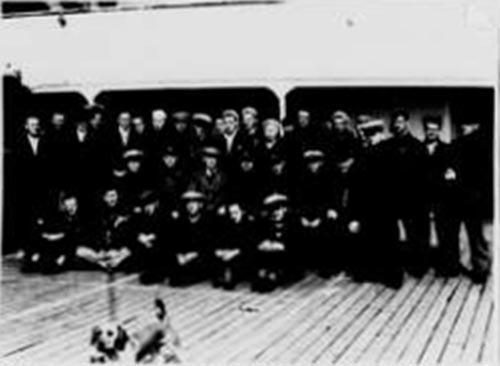 |
|
| |
|
|
Crew of the Motor ship "MORVIKEN" |
|
| |
|
|
The Captain Anthon N o r v a l l s of the Norwegian motor ship "MORVIKEN" said the following: |
|
| |
|
|
MORVIKEN was on the way from Cape Town to Calcutta. His ship was 5008 GRT and had a crew of 35 men. There was no cargo on board. His First Officer had the watch, when on the morning of 27 August 1940 first a tanker and then a second ship came in sight. On first sighting the second ship. He received the report when the second ship was sighted. At first he was not suspicious, first when he determined that the second shop had a more southerly course, he changed course about 2 stritch [22.5°] to starboard. They couldn't find anything unusual about the second steamer, He thought it was be a Norwegian from the Wilhelmsen Shipping Company, which he knew were going to Australia. He had laid with a Wilhelmsen steamer in Argentina. He had seen their usual flag-off livery, he and his officers became suspicious. The Greeks have few good ships, and, as far as he knows, these good ships don't sail east here. Even when he got closer, he could not see anything of the armament on the suspect ship. |
|
| |
|
|
Norvalls also states that in Cape Town it is believed that there are two German auxiliary cruisers in the Atlantic and one in the Indian Ocean. He did not receive course instructions, only a 22 nm course from Cape Town was prescribed for him by the Port Captain. |
|
| |
|
|
|
|
|
| |
|
|
|
|
|
 |
 |
 |
 |
 |
 |
| |
- 84 - |
|
| |
|
|
|
|
|
| |
|
|
|
|
|
| |
|
|
|
|
|
| |
|
continued |
|
|
|
| |
|
28.08.40 |
|
|
|
| |
|
07.00 |
|
Slowed to a speed of 14 knots. |
|
| |
|
|
|
|
|
| |
|
08.45 |
31°31.5'S 48°38'E |
Observed aircraft radio traffic, that was so close a bearing could not be taken. |
|
| |
|
|
NbyW 4, Sea 3, cloudy, hazy, Vis. medium |
|
| |
|
|
The enemy either has to fly to us in a large Sunderland flying boat from land, or he has immediately in the morning on 27 August sent a cruiser or auxiliary cruiser to the sinking site of the BRITISH COMMANDER, which has now set out its on-board aircraft and is searching for us. |
|
| |
|
|
|
In the first case, a pursuit by naval forces from a base is hardly possible at the great distance and also in the second case the prospect of success for the enemy is low, since the distance from the place of the sinking is about 200 nm and hazy weather and low rain clouds only allow a distance of 10 nm for the aircraft. |
|
| |
|
|
|
|
|
| |
|
20.00 |
|
Came to 11 knots. |
|
| |
|
|
|
|
|
| |
|
29.08.40 |
|
|
|
| |
|
12.30 |
34°58'S 52°55'E |
100° to starboard the masts and smokestack of a steamer come in sight. It holds course about 100° directly towards us and was larger quickly. It is identified by its high smokestack and masts as a Blue Funnel Liner, about 10,000 to 12,000 tons in size, 14 knots. |
|
| |
|
|
SbyW 6-7, Sea 5, cloudy, Vis. medium |
|
| |
|
|
|
Since this sea area was visited in order to remain undetected for a while and remain separated from the traffic routes, and an auxiliary cruiser may also come into question, turned away to to port course 70°. At the same time, the steamer also turned away to the south. |
|
| |
|
|
|
|
|
| |
|
|
|
|
|
| |
|
|
|
|
|
| |
|
|
|
|
|
| |
|
|
|
|
|
 |
 |
 |
 |
 |
 |
| |
- 85 - |
|
| |
|
|
|
|
|
| |
|
|
|
|
|
| |
|
|
|
|
|
| |
|
continued |
|
|
|
| |
|
29.08.40 |
|
|
|
| |
|
13.05 |
|
The steamer is out of sight. |
|
| |
|
|
|
|
|
| |
|
|
|
|
|
| |
|
|
After the previous events, based on the statements of the captured Captains, as well as course instructions etc. found, the following can finally be determined: |
|
| |
|
|
| 1) |
The capture of the Norwegian tanker FILEFJELL was only a result of the dashing and full commitment of the on-board aircraft. The war ruse used, the course instruction by an English plane fooled the Norwegian Captain. It is doubtful to me, however, whether an English ship would have been so well-behaved that it would have been mislead for a whole day and followed the course instructions without a radio confirmation. |
| |
|
| |
The antenna tear worked well and promises success in repetitions. |
| |
From a secret instruction in the Captain's private papers it emerges that the cargo - 10,000 tons of gasoline is not intended for Cape Town, as officially stated, but for Landsend. Secret assignment because it was feared the crew will not make the trip to the war zone around England because of the dangerousness of the cargo. |
| 2) |
It must be expected that every English steamer will try by all means to send radio messages when it is captured, even with the conscious risk of the lives of its crew. For ships other than English there is the possibility of enforcing a radio ban. |
| 3) |
The Norwegian steamer "MORVIKEN" was captured in the classic form of cruiser warfare with flag signals and 1 shot before the bow, without a radio call for help. This will remain an exception. |
| 4) |
Norwegian ships do not have the English merchant ship key on board. When they do transmit, they have to send openly. |
 |
 |
|
|
| |
|
|
|
|
|
| |
|
|
|
|
|
| |
|
|
|
|
|
| |
|
|
|
|
|
| |
|
|
|
|
|
| |
|
|
|
|
|
| |
|
|
|
|
|
| |
|
|
|
|
|
| |
|
|
|
|
|
 |
 |
 |
 |
 |
 |
| |
- 91 - |
|
| |
|
|
|
|
|
| |
|
|
|
|
|
| |
|
|
|
|
|
| |
|
continued |
|
|
|
| |
|
05.09.40 |
|
|
|
| |
|
14.10 |
30°12'S 59°58'E |
Take off. The aircraft rolled on: shortly before reaching takeoff speed the aircraft jumped a couple of times in the short swell and set down hard. Suddenly the engine mount broke off, a jet of flame shot from the break and set the tank head on fire. |
|
| |
|
|
|
The fire spread quickly over the front of the aircraft. The crew immediately left the aircraft saving the binoculars and navigation materials and was picked up by the inflatable boat that is kept ready for each take-off. The fire had now spread to the entire aircraft, and extinguishing it was hopeless. The plane fell apart and parts of it sank. |
|
| |
|
|
|
|
|
| |
|
14.25 |
|
The last of the aircraft disappeared. |
|
| |
|
|
|
|
|
| |
|
|
|
|
|
| |
|
|
|
|
|
| |
|
|
This extremely regrettable and painful loss of the aircraft is solely due to the well-known, poor take-off properties of the He 114 in moving water. According to the pilot's report, this accident - the engine breaking off while the water was moving - is typical for the He 114, and was the reason that model Arado 196 aircraft were requested for the auxiliary cruisers. Unfortunately, this requirement could not be met and due to this well-known inadequacy of the aircraft, the ship now has to complain about the loss of a means of warfare, the use of which alone had successfully captured the tanker "FILEFJELL" with 10,000 tons of gasoline. |
|
| |
|
|
The loss of the built-in FuGE 17 (VHF transceiver), only one of which was available on board, is particularly painful. |
|
| |
|
|
|
|
|
| |
|
|
|
|
|
| |
|
|
|
|
|
| |
|
|
|
|
|
| |
|
|
|
|
|
| |
|
|
|
|
|
| |
|
|
|
|
|
| |
|
|
|
|
|
| |
|
|
|
|
|
 |
 |
 |
 |
 |
 |
| |
- 92 - |
|
| |
|
|
|
|
|
| |
|
|
|
|
|
| |
|
|
|
|
|
| |
|
continued |
|
|
|
| |
|
05.09.40 |
To make the spare aircraft ready for flight, the lifting platform must be set on deck, the aircraft under the platform must be taken out of the shaft without a guide and put down until the lifting platform is inserted again into the guide rails of the shaft. Since this is only believed to be possible when the ship is in a completely calm position, with the currently prevailing light swell this is not in question. |
|
| |
|
|
|
 |
|
| |
|
|
|
|
|
| |
|
06.09.40 |
29°26'S 59°33'E |
|
|
| |
|
|
ENE 2, Sea 1-2, overcast, Vis. good |
Back and forth in position on changing courses - |
|
| |
|
|
|
at times lay stopped at night - |
|
| |
|
|
|
|
|
| |
|
07.09.40 |
29°24'S 57°43'E |
|
|
| |
|
|
ENE 3, Sea 2, cloudy, clear, Vis. good |
on the suspected steamer routes. |
|
| |
|
|
|
|
| |
|
|
|
Nothing was sighted. |
|
| |
|
08.09.40 |
29°40'S 56°49'E |
|
|
| |
|
|
NE 4, Sea 3, clear, Vis. good |
|
|
| |
|
|
|
|
|
| |
|
09.09.40 |
29°12.5'S 58°40'E |
|
|
| |
|
|
NEbyE 3-4, Sea 3, cloudy, clear, Vis. good |
|
|
| |
|
|
|
|
|
| |
|
|
|
 |
|
| |
|
|
|
|
|
| |
|
|
|
|
|
| |
|
|
|
|
|
| |
|
|
|
|
|
| |
|
|
|
|
|
| |
|
|
|
|
|
| |
|
|
|
|
|
 |
 |
 |
 |
 |
 |
| |
- 93 - |
|
| |
|
|
|
|
|
| |
|
|
|
|
|
| |
|
|
|
|
|
| |
|
|
|
|
|
| |
|
10.09.40 |
27°55'S 58°25'E |
|
|
| |
|
|
NNW 3-4, Sea 3, clear, Vis. good |
|
|
| |
|
|
|
|
|
| |
|
|
|
|
|
| |
|
|
Therefore, before I leave this sea area to arrive in the Australian sea area around the end of September according to orders, I decide to make another advance in the direction of Madagascar, as I assume with certainty that I will come across the steamer traffic that has so far been sought in vain. |
|
| |
|
|
|
|
|
| |
|
|
|
|
|
| |
|
13.30 |
|
The following message was heard from the British steamer "CLAN MACFADYEN": |
|
| |
|
|
|
"QQQ 1840 S 7054 E BENARTY bombed plane from ship." |
|
| |
|
|
|
|
|
| |
|
18.30 |
|
The same message was received several times from he British steamer "GLANBEG" and acknowledged by Natal Radio. |
|
| |
|
|
|
|
|
| |
|
|
|
|
|
| |
|
|
I assume that it is the result of the operation of Ship 16 with its on-board aircraft. |
|
| |
|
|
|
|
|
| |
|
|
|
|
|
| |
|
11.09.40 |
26°05'S 53°52'E |
No particular events. |
|
| |
|
12.00 |
SSE 5, Se 4, cloudy, clear, Vis. good |
|
|
| |
|
|
|
 |
|
| |
|
|
|
|
|
| |
|
|
|
|
|
| |
|
|
|
|
|
| |
|
|
|
|
|
| |
|
|
|
|
|
 |
 |
 |
 |
 |
 |
| |
- 95 - |
|
| |
|
|
|
|
|
| |
|
|
|
|
|
| |
|
|
|
|
|
| |
|
continued |
|
|
|
| |
|
12.09.40 |
|
|
|
| |
|
07.26 |
|
Flag signal: |
|
| |
|
|
|
"Stop immediately" |
|
| |
|
|
|
"Radio traffic is forbidden" |
|
| |
|
|
|
At the same time bow cannon 1 shot before the bow. |
|
| |
|
|
|
|
|
| |
|
07.27 |
|
Steamer turned away immediately and showed us the stern. |
|
| |
|
|
|
Battery exposed |
|
| |
|
|
|
|
|
| |
|
07.28 |
|
1 salvo |
|
| |
|
|
|
The steamer does not stop. |
|
| |
|
|
|
|
|
| |
|
07.29 |
|
1 salvo. |
|
| |
|
|
|
The steamer opens fire on us, shoots 500 meters short. |
|
| |
|
|
|
|
|
| |
|
07.30 |
|
Battery receives permission to open fire. |
|
| |
|
|
|
The steamer tries to avoid hits by hard rudder maneuvers. Initially this made shooting in more difficult. During this time the steamer fired five more times, one shot of which is observed short, all the others apparently long. However, a shell ricochets off the water about 10 meters in front of the ship, penetrates the port side of the hull without detonating, and penetrates a living space without causing major damage. The impact could not be felt on the bridge |
|
| |
|
|
|
|
|
| |
|
07.32 |
|
With the 8th salvo the steamer received a hit in the stern, by which the cannon was knocked out of action. |
|
| |
|
|
|
The artillery now lies well at the target, the steamer continues on, a hit tears the masthead with radio yardarm and antenna away, more hits in the hull, smokestack, boats, cargo holds and finally in the bridge. |
|
| |
|
|
|
|
|
| |
|
|
|
|
|
| |
|
|
|
|
|
| |
|
|
|
|
|
 |
 |
 |
 |
 |
 |
| |
- 96 - |
|
| |
|
|
|
|
|
| |
|
|
|
|
|
| |
|
|
|
|
|
| |
|
continued |
|
|
|
| |
|
12.09.40 |
|
|
|
| |
|
|
|
The steamer turned to starboard, and continues on soon burning completely. |
|
| |
|
|
|
|
|
| |
|
07.39 |
|
Once more sent signal: |
|
| |
|
|
|
"Stop immediately!" |
|
| |
|
|
|
|
|
| |
|
|
|
Because the steamer does not stop, it was accepted that the bridge was completely out of action and the engines were left to run. |
|
| |
|
|
|
|
|
| |
|
07.40 |
|
Stop, battery cease fire. |
|
| |
|
|
|
|
|
| |
|
|
|
The steamer was identified as the British "BENAVON", 5872 GRT, 12 knots, built in 1030. The steamer made little speed and came to a stop. By observation on board it did not transmit. The crew abandoned the steamer on rafts. |
|
| |
|
|
|
|
|
| |
|
08.02 |
|
The prize commandos set off, to capture the crew and if it was possible on the burning ship, to perform demolition. The smoke development of the burning steamer is very great, can be seen for 30 nm. |
|
| |
|
|
|
|
|
| |
|
|
|
|
|
| |
|
|
I regret this because of the possible presence of English Naval Forces in this sea area, all the more as for the first time there was no radio warning from this English steamer when it was stopped. |
|
| |
|
|
Therefore I intend to move off as soon as possible. |
|
| |
|
|
|
|
|
| |
|
|
|
|
|
| |
|
|
|
|
|
| |
|
|
|
|
|
| |
|
|
|
|
|
| |
|
|
|
|
|
 |
 |
 |
 |
 |
 |
| |
- 99 - |
|
| |
|
|
|
|
|
| |
|
|
|
|
|
| |
|
|
|
|
|
| |
|
continued |
|
|
|
| |
|
12.09.40 |
|
|
|
| |
|
|
|
Flag message of the Examination Officer: |
|
| |
|
|
|
'Demolition not possible due to list". |
|
| |
|
|
|
|
|
| |
|
08.15 |
|
Prize crew on board |
|
| |
|
|
|
The Prisoner Officer reports, that the steamer loaded hemp and rubber in Manila and Singapore and was destined for London (via Durban to bunker). |
|
| |
|
|
|
Captain and Officers had fallen, according to statements of the Chief Engineer, the IV Engineer and both radio men, no radio message was given because the system was not in service. |
|
| |
|
|
|
The demolition was not carried out, because the steamer already had a list, also the boat could no longer approach because of the great heat radiation and the ready ammunition on board was already going into the air. |
|
| |
|
|
|
28 men of the crew were taken on board, among them 1 dead, and 4 severely wounded. The sinking of the steamer, which burns completely and has several hits close to the waterline, is accelerated by shots in the waterline. |
|
| |
|
|
|
|
|
| |
|
09.03 |
|
1st and 6th cannons permission to fire. |
|
| |
|
|
|
|
|
| |
|
09.09 |
|
Ceased fire, the hit holes in the steamer draws in more and more water, the stern comes further out of the water. With the prevailing swell, the steamer, which is already glowing in many places, is gradually filling up. |
|
| |
|
|
|
|
|
| |
|
|
|
|
|
| |
|
|
|
|
|
| |
|
|
|
|
|
| |
|
|
|
|
|
| |
|
|
|
|
|
| |
|
|
|
|
|
| |
|
|
|
|
|
 |
 |
 |
 |
 |
 |
| |
- 101 - |
|
| |
|
|
|
|
|
| |
|
|
|
|
|
| |
|
|
|
|
|
| |
|
continued |
|
|
|
| |
|
12.09.40 |
|
|
|
| |
|
|
The ship now has 171 prisoners on board. This means that the possibility of accommodating prisoners is exhausted as long as the mine rooms are still full of mines. Therefore I very much hope to get my hands on a ship in transit to Australia that is suitable for being sent home with the prisoners on board as a prize. Because of the great distance, only a motor ship can be used for this. |
|
| |
|
|
In view of the imminent drastic change in the area of operations, it seems to me that the opportunity to send a radio report to home before leaving the previous sea area is not only favorable, but that radio direction finding of the ship is even desirable, since in connection with the events that have become known to the enemy so far, it would reduce the insecurity and uncertainty about the actual situation in the Indian Ocean with regard to commerce raiders will continue to obscure. |
|
| |
|
|
For the considerations of mine operations in Australia, knowledge of the previous mining activities of Ship 36 is necessary as soon as possible. |
|
| |
|
|
In addition, I consider it advisable to inform the Skl. about the discovered written instructions from the steamers, wherever possible to proceed outside the 200-meter line. Furthermore, I think it is appropriate to report the hit received when a steamer was captured, since the attitude of English captains is characteristic and, deserves to be passed to the other HSKs as a warning. |
|
| |
|
|
In order not to forfeit the possibility of raising a suitable prize on the Sunda route by transmitting, I decide to first send the radio message at 32°S and 63°E. |
|
| |
|
|
|
|
|
| |
|
13.09.40 |
27°45'S 56°26'E |
|
|
| |
|
12.00 |
NEbyN 2-3, Sea 2, cloudy, Vis. good |
No particular events. |
|
| |
|
|
|
 |
|
| |
|
|
|
|
|
| |
|
|
|
|
|
| |
|
|
|
|
|
| |
|
|
|
|
|
| |
|
|
|
|
|
| |
|
|
|
|
|
| |
|
|
|
|
|
| |
|
|
|
|
|
 |
 |
 |
 |
 |
 |
| |
- 102 - |
|
| |
|
|
|
|
|
| |
|
|
|
|
|
| |
|
|
|
|
|
| |
|
|
|
|
|
| |
|
14.09.40 |
30°10'S 59°58'E |
|
|
| |
|
10.50 |
NWbyW 4, Sea 3-4, overcast, Vis. good |
Burial of the First Radio Operator of the sunken steamer "BENAVON". |
|
| |
|
|
|
|
|
| |
|
|
|
|
|
| |
|
|
Statements of the First Engineer P o r t e o u s, Second Engineer C r a w f o r d, Officer Candidate G r a h a m, Second Radio Operator S i n g e r, Boatswain O l l e s o n of the "BENAVON". |
|
| |
|
|
|
|
|
| |
|
|
Graham said: |
|
| |
|
|
|
|
| |
|
|
His ship was loaded with wood (about 1300 tons), hemp (1500 tons) and rubber (about 5500 tons). It was fully loaded. The coal inventory amounts to about 380 tons and about 800 tons were to be supplied in Durban. Daily coal consumption at 11.5 knots amounted to 45 tons. The ship was on the way from Manila via Singapore, Port Swettenham, Penang and Durban to London. Penang was abandoned on August 28, 1940. In Durban they expected orders for the next port to be called, possibly to proceed in convoy. It was assumed that this would be Freetown. |
|
| |
|
|
At the beginning of the war they had to paint the superstructure gray and the smokestack black. Later they painted the superstructure brown, allegedly without special order from the Admiralty, while the smokestack remained black. |
|
| |
|
|
Their armament consisted of 2 cannons, a 10.5 cm and a 7.6 cm anti-aircraft cannon. There was no special lookout. The crew consists of a gunner who was a former member of the Navy and around 51 years old, 2 cadets and 4 sailors. The Second Officer was in charge of the armament. All except the gunner were trained in a 14-day gun training course at the start of the war. The last gun drill was done in Singapore. On the trip they did not do any regular exercises at the gun. |
|
| |
|
|
In his opinion, the Captain was a nice guy. He would have rather have had the fight at night, since it was already hopeless for them after the first volleys, he should have stopped. In any case, however, the behavior in the event of meeting |
|
| |
|
|
|
|
|
| |
|
|
|
|
|
| |
|
|
|
|
|
| |
|
|
|
|
|
| |
|
|
|
|
|
| |
|
|
|
|
|
 |
 |
 |
 |
 |
 |
| |
- 104 - |
|
| |
|
|
|
|
|
| |
|
|
|
|
|
| |
|
|
|
|
|
| |
|
continued |
|
|
|
| |
|
14.09.40 |
The First Engineer Porteous and Second Engineer Crawford said. |
|
| |
|
|
|
|
|
| |
|
|
The "BENAVON" had a 49 man crew on board. It belonged to the Shipping Company B. Thomson & Co. (Benline) in Leith (Scotland). The "BENAVON" left on the outbound journey from Southhampton on 5 May with a full load of general cargo and for the first time proceeded, not through the Suez Canal, but around the Cape of Good Hope. To the best of his knowledge, the ship was not chartered by the English government, but was making its usual routine voyage to East Asia. |
|
| |
|
|
In Penang Porteous saw an English cruiser, in the other ports no warships, but knew that there were English war ships in Singapore. They have not seen any ships since they left Penang (This statement was also confirmed by other prisoners). Two days ago, his Chinese firemen had told him about the bombing of a shipping company ship by an airplane and remarked that they did not want to let themselves be bombed. Captain Thomson, the leader of the "BENAVON" when asked by the Chief Engineer, stated that this was only a rumor and that he, the Chief Engineer, should try to convince the Chinese of the falseness of this report. |
|
| |
|
|
On the last voyage home, the "BENAVON" unloaded its main load in London at the beginning of May without any difficulties. |
|
| |
|
|
Porteous was still in bed at the first shot, like most of the people. He later saw the Captain on the bridge, but didn't speak with him again. |
|
| |
|
|
Crawford reported on a conversation he had with the gunner a few days ago. The latter told him that they could not allow themselves to be hijacked without first having fought. They had heard that German raiders were not taking prisoners. It was said that a boat with no people was found floating in the Indian Ocean; this boat had many holes from machine-gun bullets. After their experience with a German raider, they had to admit that newspapers and stories are unbelievable. |
|
| |
|
|
|
|
|
| |
|
|
|
|
|
| |
|
|
|
|
|
| |
|
|
|
|
|
| |
|
|
|
|
|
| |
|
|
|
|
|
| |
|
|
|
|
|
| |
|
|
|
|
|
| |
|
|
|
|
|
| |
|
|
|
|
|
| |
|
|
|
|
|
 |
 |
 |
 |
 |
 |
| |
- 105 - |
|
| |
|
|
|
|
|
| |
|
|
|
|
|
| |
|
|
|
|
|
| |
|
continued |
|
|
|
| |
|
14.09.40 |
Crawford stated that when the engagement opened he received an order from the bridge to run at full speed. The order was given by repeatedly setting the machine graph to "Full Speed Ahead", and was approx. 2 minutes after the German raider fired the shot before the bow of the "BENAVON". Since then the Second Engineer on watch has not received any orders from the bridge. Crawford stated that he remembered that when the engine was switched off - it was done on its own initiative, since steam penetrated the engine room - the lever on the engine telegraph was in the "Stop" position. He assumed and still assumes that the telegraph was damaged by a hit and the lever fell down as a result. (At Full Speed the lever had to be up and down, at Stop it had to be down.) |
|
| |
|
|
The Chinese of the stoker's watch, with the exception of one greaser, left the engine room at the first shot. After the battle opened, the Chief Engineer came into the engine room, but did nothing of his own accord to stop the ship or to contact the bridge. When the battle was over, they went on deck and took part in bringing a raft to water on the quarterdeck. the Captain was said to have been a nice and sociable man. They are of the opinion that he began the battle on the general orders of the Admiralty. They now condemn his actions and would have thought it better to stop the ship immediately. They agree that the behavior in the event of an encounter with a German raider was precisely defined beforehand. |
|
| |
|
|
|
|
|
| |
|
|
The Second Radio Operator Singer stated: |
|
| |
|
|
He was making his first voyage with this ship. Most of the work in the Radio Department was done by the First Radio Operator. He had nothing to report about English naval forces. A few weeks ago the system according to which the received code telegrams were deciphered was changed. But the book was not changed. They hardly sent any telegrams as this was forbidden. Normally the Captain, who also had the code, decrypted the telegrams received, but the Radio Operators supported him every now and then. There had been |
|
| |
|
|
|
|
|
| |
|
|
|
|
|
| |
|
|
|
|
|
| |
|
|
|
|
|
| |
|
|
|
|
|
| |
|
|
|
|
|
| |
|
|
|
|
|
| |
|
|
|
|
|
| |
|
|
|
|
|
| |
|
|
|
|
|
| |
|
|
|
|
|
 |
 |
 |
 |
 |
 |
| |
- 107 - |
|
| |
|
|
|
|
|
| |
|
|
|
|
|
| |
|
|
|
|
|
| |
|
continued |
|
|
|
| |
|
15.09.40 |
After sending the radio messages I began the easterly transit to Australia. In order to be able to carry out the first mining operation on the east coast of Australia in the new moon period around 1 October, the transit must be carried out at 11 knots. I intend to proceed at about 30° south latitude towards the Australian steamer coming home in the good weather zone. |
|
| |
|
|
|
 |
|
| |
|
12.00 |
31°29'S 64°46'E |
|
|
| |
|
|
NW 3-4, Sea 3, overcast, Vis. good |
|
|
| |
|
|
|
|
|
| |
|
|
|
|
|
| |
|
20.45 |
31°08'S 66°34'E |
Burial of the Fourth Engineer of the sunken steamer "BENAVON" who died of his wounds. |
|
| |
|
|
|
|
|
| |
|
|
|
|
|
| |
|
16.09.40 |
30°31.5'S 69°09'E |
Steamer in sight to port. |
|
| |
|
09.04 |
NW 3, Sea 3, overcast, Vis. good |
Bearing 55°T |
|
| |
|
|
|
|
|
| |
|
09.07 |
|
Closed on course 35°, 14 knots. |
|
| |
|
|
|
Crew to Action Stations. |
|
| |
|
|
|
|
|
| |
|
09.12 |
|
2 masts, smokestack and left of that bridge of a motor ship are distinguished. |
|
| |
|
|
|
Westerly course. |
|
| |
|
|
|
|
|
| |
|
09.18 |
|
Range 23000 meters Bearing 59°T. |
|
| |
|
|
|
Changed course and speed (about 11 knots) , until the range drops. |
|
| |
|
|
|
|
|
| |
|
|
|
|
|
| |
|
|
|
|
|
| |
|
|
|
|
|
 |
 |
 |
 |
 |
 |
| |
- 109 - |
|
| |
|
|
|
|
|
| |
|
|
|
|
|
| |
|
|
|
|
|
| |
|
continued |
|
|
|
| |
|
16.09.40 |
|
|
|
| |
|
10.40 |
|
Flag message of the Examining Officer: "M.S. NORDVARD", Oslo, from Australia for Port Elizabeth, 4111 GRT, 7187 tons of wheat in sacks, speed 10.5 cm. Oil for 10 days at full speed. Between decks could be expanded for prisoners. 29-man crew. Provisions for 1 1/2 weeks. Fuel oil capacity 900 tons = 20000 nm. |
|
| |
|
|
|
Examining Officer received orders, to take the steamer as a prize. |
|
| |
|
|
|
The Prize crew remained on board. |
|
| |
|
|
|
|
|
| |
|
|
|
Secret papers were not found. |
|
| |
|
|
|
|
|
| |
|
|
|
The steamer had not transmitted. |
|
| |
|
|
|
|
|
| |
|
11.35 |
|
Examination commandos on board. By statement of the Examining Officer the steamer is suitable as prize to take all the prisoners to the homeland. |
|
| |
|
|
|
According to an earlier instructions from the Admiralty, the steamer destroyed the nautical charts of the sea area. The ship loaded wheat alone in the small port of Bunbury at Freemantle and only had communicated with the Australian Customs authorities. No ship had yet been sighted on the voyage. The steamer makes a harmless impression, Norwegian crew. |
|
| |
|
|
|
|
|
| |
|
|
|
|
|
| |
|
|
To outfit and prepare the prize, I decide to proceed with her about 180 nm northeast into the high-pressure area there and hope that at least the southwest swell, which is currently very objectionable, has subsided there. |
|
| |
|
|
|
|
|
| |
|
|
|
|
|
| |
|
|
|
|
|
| |
|
|
|
|
|
| |
|
|
|
|
|
 |
 |
 |
 |
 |
 |
| |
- 111 - |
|
| |
|
|
|
|
|
| |
|
|
|
|
|
| |
|
|
|
|
|
| |
|
continued |
|
|
|
| |
|
16.09.40 |
The prize "NORVARD" is very well suited for the intended purpose of taking the prosiners off the ship. After stowing a number of the wheat sacks, on which the prisoners sometimes sleep with mats, the prisoners can easily be accommodated in two gaps in the intermediate deck. The officers went in threes into the steamer's officers' quarters. The prize crew can be closed off from and housed in the bridge structure separated from the rest of the ship at night by removing the stairs. Provision rooms are only accessible from here. Cooking and baking equipment is sufficient. The cargo - 7,000 tons of wheat in sacks - will be very useful in occupied France. The only, albeit very sad, mistake of the prize is that it only has fuel for 10 days. The steamer last took oil in Canada months ago - full bunkers - 900 tons - and must now fall into our hands with empty bunkers of all things. |
|
| |
|
|
|
|
|
| |
|
|
|
|
|
| |
|
17.09.40 |
|
In the morning established a a tow connection between the drifting ship, in such a way that 33, which drifts faster as a larger ship, attaches itself to NORDVARD ". Both ships lay staggered athwart the windd and light swell at the length of the towline - about 150 meters - and in relation bow to stern. Oil and water lines were passed over and , luggage and provisions were conveyed by two motorboats. |
|
| |
|
|
|
The Norwegian crew of the prize as well as the steamer "MORVIKEN", who were transferred for the purpose first thing in the morning, work |
|
| |
|
|
|
|
|
| |
|
|
|
|
|
| |
|
|
|
|
|
| |
|
|
|
|
|
| |
|
|
|
|
|
| |
|
|
|
|
|
| |
|
|
|
|
|
| |
|
|
|
|
|
| |
|
|
|
|
|
| |
|
|
|
|
|
| |
|
|
|
|
|
| |
|
|
|
|
|
| |
|
|
|
|
|
| |
|
|
|
|
|
 |
 |
 |
 |
 |
 |








